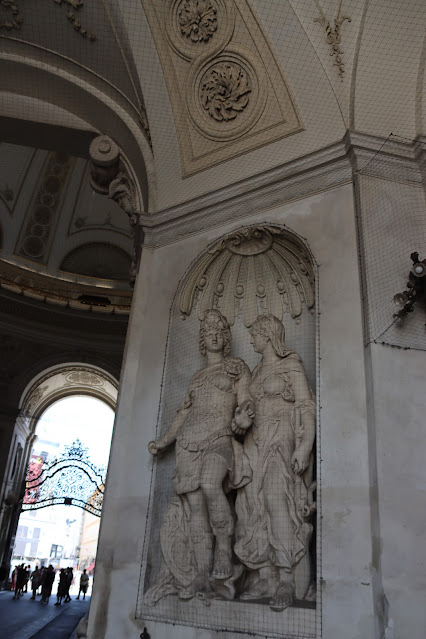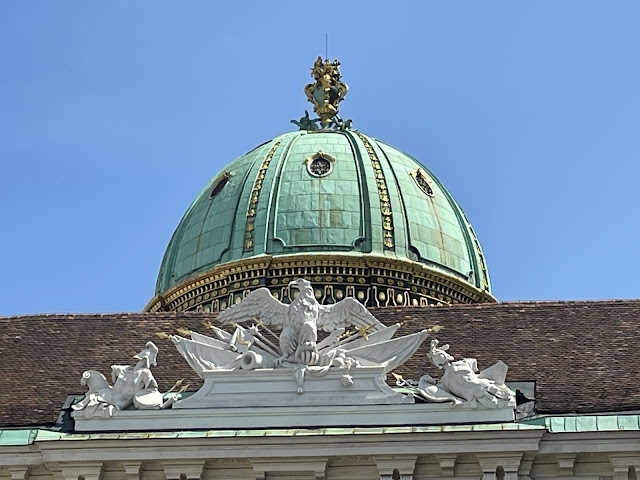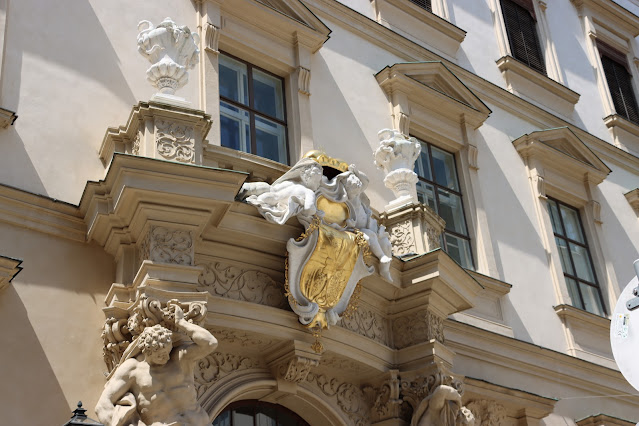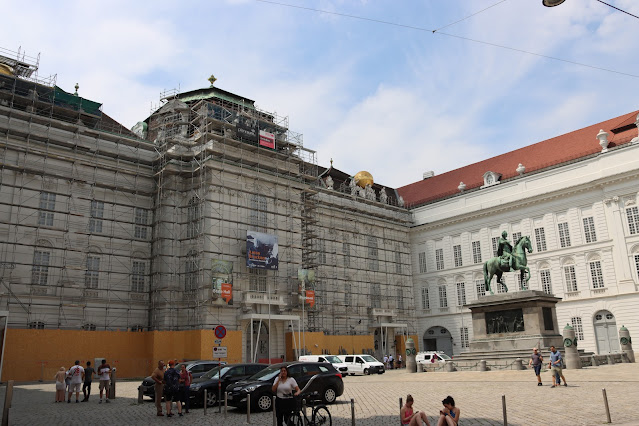Today we headed into Vienna, but not before a little bit of excitement, when a giant green grasshopper got into the bathroom. It didn't do any harm but Tomas' response was "Oh, hell no" in a strange American drawl. It was about the size of my middle finger.
We started our day at the Kunsthistorisches Museum (Art History Museum), taking a train from our apartment into the middle of Vienna.
The museum is famous for its octagonal dome and being the largest art museum in Austria and one of the most important in the world.
It was opened in 1891 by the Emperor of Austria-Hungary, Franz Joseph I to house the Habsburg' art collection so it would be available for the general public.
 |
| Afrika statue - Representing Africa |
 |
| Asien Statue - Representing Asia |
Also in the square was the Maria Theresa Memorial, which commemorates Empress Maria Theresa who ruled the Habsburgs from 1740-1780.
Across from the Art Museum was the Hofburg, the former Imperial Palace of the Habsburgs. It was built in the 1200s and served as the winter palace, with Schönbrunn Palace as the summer. The name means "Castle of the Court". There is a good map of all of the wings, their names and the year they were constructed here
 |
| Neue Burg Wing (New Castle) - last expansion in 1860, houses museums |
 |
Statue of Archduke Charles in Heldenplatz (Heroes Square)
|
 |
| Flags on the Festival Hall Wing - Cam and Tomas spent time to name all the countries on them. Turns out they were outside the Organization for Security Cooperation In Europe (OSCE) HQ so maybe we shouldn't have been taking so many photos... |
 |
| St Michael's Wing - named after St Michael's Church |
We considered a stop in at the butterfly house, and so Kris asked Tomas to go and check the price. He came back and told us it was 15 euro ($25) each. To prove that I have corrupted my children I asked him if that was the all-you-can-eat price, or the price for just one and he didn't even blink an eyelid. Later (on the 23rd when we were in Rejika) he proved the corruption even more admitting that he hadn't checked the price because he didn't want to go in, so he just made up a price he knew we wouldn't want to pay. The kid is a pain!
Passing out of the Palace, we passed under the double headed eagle - the symbol of the Habsburg dynasty:
We then passed the Michaelerkirche, Saint Michael's Church, one of the oldest churches in Vienna, built in 1200s.
We also passed the "Die Macht zu Lande" (Power on Land) and "Die Macht zur See" (Power on Sea) fountains, which were unfortunately closed for renovations - leading to an interesting photo and a foot coming from nowhere:
From Googlemaps, this is what it should look like:
We then continued on our walk, passing a few more iconic buildings.
First was the Minoritenkirche (Friars Minor Conventual Church), formerly named Italian National Church of Mary of the Snows. the church was completed in 1350 and served as a church for the followers of Francis of Assisi. It was gifted to the Italians by Joseph II in 1782 and renamed as Mary of the Snows. In 2019 the Italian Congregation of Mary of the Snows fell out with the priest in charge of the church and the Archdiocese moved to the Church of the Holy Trinity of the Friars Minor. In 2021 the congregation donated the church to the Society of Saint Pius X, which is a traditional Catholic Clerical Fraternity.
We had to then take a slight detour as the road we intended to take was closed for filming around the Stadtpalais Liechtenstein (Liechtenstein State Palace):
After a few side streets we came to the Burgtheater (Castle Theatre), which first opened in 1741:
Our next stop was the impressive Rathaus (City Hall). There was a film festival in progress that hampered our ability to get a clear photo of the whole building, but we did get to partake in the food court. Tom and I got a proper Wiener Schnitzel and Kris and Cam got a kebab plate. The food was good, but 25 euro (AUD $41) for a schnitzel, chips and cokes was a bit crazy!
The pedestrian crossing lights outside the hall were cool:
The stop lights have been done to be LGBT friendly, including gay and lesbian couples:
After some food and a break, we headed on to our next stop - the Austrian Parliament House. The Parlamentsgebäude is the 13,500 square meters in size and was built in 1902:
We then passed the Albrechtsbrunnen, Albrecht's Fountain, named after Field Marshal Archduke Albrecht of Austria-Teschen who lived in the Palace at Albertina at the time.
I'd heard some amazing things about the Austrian National Library, Österreichische Nationalbibliothek), which holds over 12 million items and is housed in the Neue Burg Wing of the Hofburg. Unfortunately it was under renovation and so we decided not the pay the cost to see the insides:
Our second to last stop was St Stephen's Square and the very impressive St Stephen's Cathedral. The ground was broken for the Cathedral in 1137 and it was completed in 1578. At 107m long, 70m wide and with two spires at 136.4m and 68.3m meters it was an imposing sight.
St Stephen's Square had some pretty cool building facades and the Plague Column (die Wiener Pestsäule), which was built in 1679 after Vienna suffered one of the last major plague epidemics. the Habsburg emperor Leopold I fled the town and swore to build a mercy column if the plague ended.
And I had to include these from one of the souvenir stores - showing the famous people - Verstappen, Michael Jackson, Ronaldinho, Djokovic, Maradona and Jamaica??

Since we had dragged the kids through a series of castles, towns and churches we decided that they needed to do something exciting, so we took them out to Prater - one of the oldest amusement parks in the world, including a 65m tall Ferris wheel. One of the interesting parts of the park is that most of the rides is run by different companies. The park was opened in 1766, having served as a imperial hunting grounds previously. The theme park component, Wurstelprater opened in 1895.
There are over 250 attractions, some still original. The Ferris Wheel which opened in 1897 for Franz Joseph's Golden Jubilee survived the first World War and most of the second, but was bombed and burnt down in the last few days of WWII. It was rebuilt with 15 of the 30 original gondolas.
The kids had the option to go on a few rides and chose to ride the Black Mamba twice and the Free Fall Tower.
 |
| Boys on the Black Mamba |
Story reads approximately: Once in a deep well hole, a monster smelled very bad. In the reflection it discovers itself. The basilisk has scared itself to death. Since then a lot of time and years have passed. Now he lives anew, uncaptured. The Spassilisk is having fun today. So come in, dear people."
After finishing up at the park, we headed back to the carpark and picked up our car. Since it was free to park outside our apartment overnight, we moved the car to the short term parking, ready to pack the next morning.
















































































































No comments:
Post a Comment